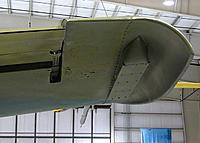Aeroalias, ROIMaison, et al all provide excellent explanations and I believe they're correct. However, I think there are two additional possibilities for this wing-tip design.
I have no specific knowledge that indicates the A-10 design considered these issues, but I suspect (educated guess by an Aero & Astro Engineer currently working with the A-10C) one, the other, or both may have been part of the design decision.
 Note: the wing tip is very delicate and does not extend far enough to provide support during gear-up landings.
Note: the wing tip is very delicate and does not extend far enough to provide support during gear-up landings.
The wing tip devices aren't large enough to protect the decelerons

Or even from more modest aileron deflections

Even if the wing tip devices were larger, the wing dihedral keeps those wing tip devices farther above the ground, even during a gear-up landing, than the ailerons (as shown in the first picture).
Ground Effect
There's another reason for the wingtip "droop" (Hoerner Wing Tip) (note: other references for the Hoerner Wing Tip provide photos or diagrams of several different possible configurations) besides the improved wing efficiency from the winglet effect, namely ground-effect.
For fixed-wing aircraft, ground effect is the reduced aerodynamic drag
that an aircraft's wings generate when they are close to a fixed
surface. During takeoff, ground effect can cause the aircraft to
"float" while below the recommended climb speed. The pilot can then
fly just above the runway while the aircraft accelerates in ground
effect until a safe climb speed is reached.
The A-10 was designed for short takeoff and landing operations. For this type of operation, landing in a short distance is harder than taking off (especially from primitive fields). Ground effect allows a plane to fly slower and remain airborne by providing a region of increased high pressure below the wing when it is close to the ground (low-winged aircraft benefit more from this effect than high-winged aircraft). This allows for lower landing and take-off velocities, which in turn allow for shorter take-off and landing distances.
The Hoerner Wing Tip helps trap this region of high-pressure air under the wing.
Improved Stability
Another possible reason for this configuration, which I discovered while linking references, was apparently the Hoerner Wing Tip helps reduce control instability in dutch roll for wings with dihedral.
This addition was done in order to counteract the dutch roll
characteristic present in the original He 162 design, related to its
wings having a marked dihedral angle.

I wasn't aware of dutch roll instability concerns in the A-10 design before the addition of the Hoerner wing tips but its wing does possess a dihedral. All images that I've seen of the YA-10A wing include the Hoerner wing tip.















